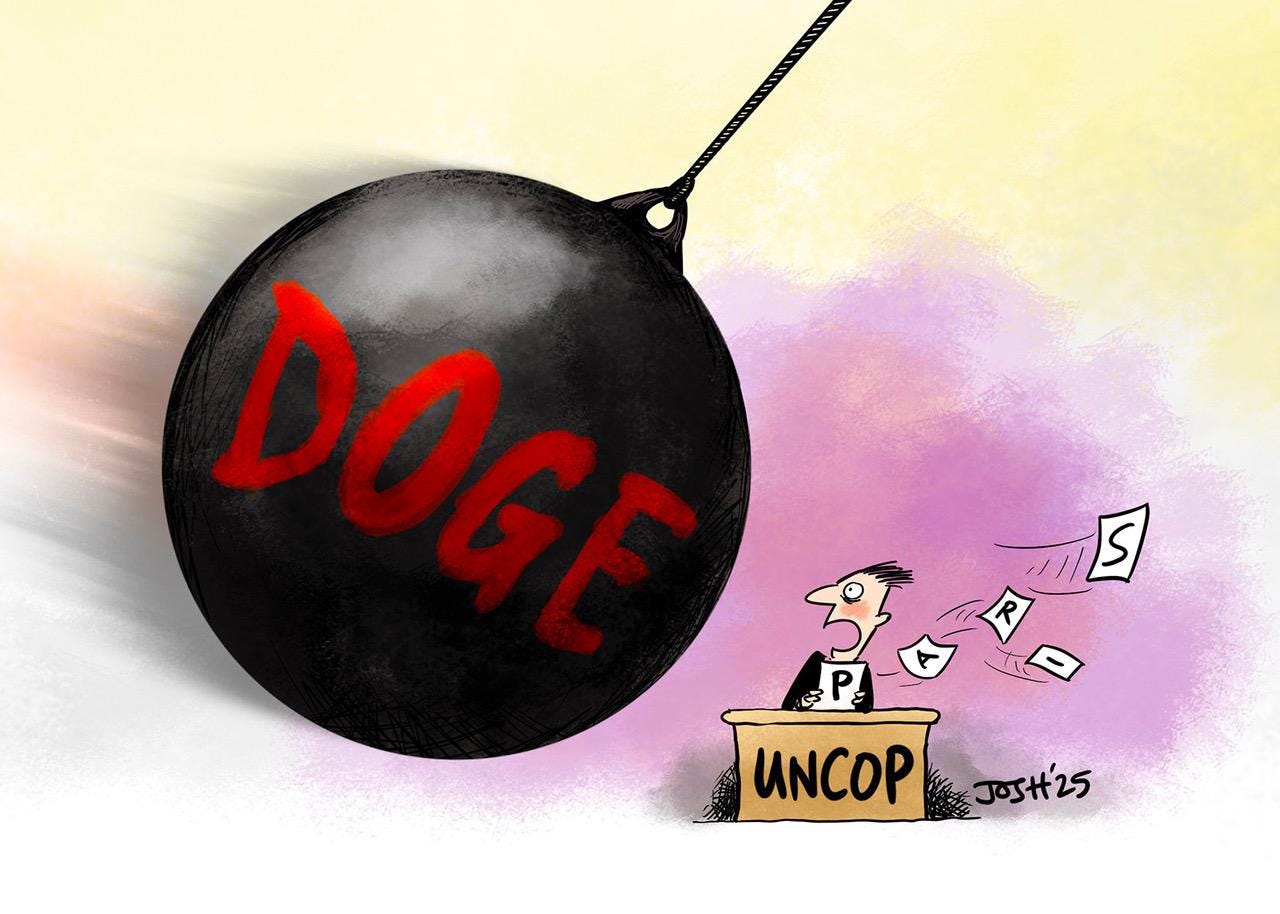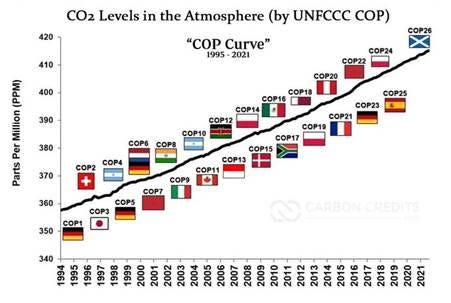cartoonsbyjosh.com
It has been a whirlwind since Mr. Trump took office on January 20th. It is not too much of a stretch to compare Elon Musk’s DOGE raid and swift dismantling of USAID’s operations last week to the fall of the Bastille in Paris in 1789 in historical significance. Putting aside the grand rhymes of history, the revolutionary fervour in the Washington DC air is palpable as the deep state is being dismantled in real time.
With the daily revelations of corruption and subterfuge in the nation’s capital unearthed by the Trumpian revolution, there is the growing perception among ordinary people that the gap between reality and official narratives peddled by the mainstream media is ever wider. Nowhere is this disjunction more on display than in the areas of climate change and energy policy after President Trump’s decision to exit the Paris climate agreement.
A closer look at the transcript of a speech by the UN Climate Change Executive Secretary Simon Stiell delivered last week in Brasilia will illustrate this gap between what most observers would broadly regard as objective reality and the official narrative as delivered by a highly place UN functionary. There is nothing uniquely important or special about Mr. Stiell or his speech, but that is precisely why it is useful for our purpose here.
Narrative Assertions
The speech starts off with the assertion that “without UN-convened global climate cooperation – with its origins right here in Brazil in 1992 – we would be headed towards up to 5 degrees of global heating – a death sentence for humanity as we know it.”
A reasonably informed layperson in the audience would have whipped out the following chart to challenge it. To the naked unjaundiced eye, the annual UN climate jamborees have not made one whit of a difference.
(source: https://x.com/FrogstarWorld/status/1888145907561927165 )
And to anyone faintly familiar with global energy trends, it would come as no surprise that the world’s largest emitters of CO2 in Asia, such as China, India, Indonesia and Vietnam, have in fact gained momentum in capacity additions to their coal mining and coal power generation sectors. Global coal use is set to reach an all-time high in 2024, marking the third consecutive year of record-breaking consumption.
It is enough for readers to be aware that there is no “settled science” that authoritatively correlates man-made CO2 emissions to global temperatures, without even engaging into questions of causality. For Mr. Stiell to blithely state that the Paris agreement saved the world from a “death sentence” is egregious to say the least.
Mr. Stiell’s next big assertion – and it seems that his speech is full of these – is that “the clean energy shift is now unstoppable: because of the colossal scale of economic opportunity it presents.” Where have we heard of this before? Yes, Mad Ed said precisely this in arguing that President Trump’s decision to exit the Paris argument would not slow the energy transition.
Mr. Stiell seeks to adds factual backbone to that tall-order claim: “Because when 2 trillion dollars flow into clean energy and infrastructure in just one year, as they did last year, you can be sure it’s not because of virtue signaling.”
Presumably, Mr. Stiell is referring to the annual report released recently by BloombergNEF which reported that investment in the “low-carbon energy transition” worldwide grew 11% to hit a record $2.1 trillion in 2024. According to the report, investment in the low-carbon energy transition was driven by renewable energy, power grids and electrified transport and energy storage investment primarily in mainland China, which accounted for $818 billion of investment. This, of course, is the same China that accounted for 95% of the world’s new coal power construction activity in 2023.
To put the $2.1 trillion and the “energy transition” in context, we can turn to a 2021 speech by Mr. Chris Wright, the recently-appointed Energy Secretary of the Trump administration. He asked, “how has the energy transition gone so far”? And he answered, that after $2 trillion in subsidies over the 2 decades from 2000, the world dependence on fossil fuels for its primary energy demand “plunged” all the way down to 84% from 86%.
According to Jeff Currie, who was Goldman Sachs’ Global Head of Commodities Research, the contrast is even worse. In an interview in 2022, he said fossil fuels represented 81% of energy consumption at end-2021. “Ten years ago, they were at 82%...$3.8 trillion of investment in renewables moved fossil fuels from 82% to 81% of the overall energy consumption."
Mr. Stiell’s reference to $2.1 trillion in clean energy and infrastructure gives no clue as to the returns on such investment (if any) and also leaves out the question as to whether those investments were based on government subsidies, such as those made available under President Biden’s duplicitously misnamed Inflation Reduction Act or those in China’s notoriously opaque government-directed investments.
As Mr. Steill gave his speech in Brasilia, the following headlines related to the poor performance of green investments were hard to miss:
Financial Times (February 5th): “World’s biggest offshore wind developer Ørsted slashes investment by 25%”
BBC News (February 6th): “Norwegian oil giant [Equinor] cuts green investment in half”
Nor are these headlines indicative of random business events. The Renewable Energy Industrial Index (RENIXX), a global stock capitalisation index of the 30 largest renewable energy industrial companies in the world, is down three years in a row from 2021, having lost half its value. This performance would have been far worse if the outperforming Tesla stock was removed from the index. The iShares Global Clean Energy ETF, constituting a set of key clean energy stocks around the world, fell in value by over 65% from a January 2021 peak to January 2025.
Mr. Steill’s reference to “the colossal scale of economic opportunity” that clean energy supposedly represents, made possible by the concert of nations cooperating via the Paris climate agreement, suffers a lack of truth in advertising, to say the least.
The House of Cards That Is The Paris Agreement
Perhaps the most jarring aspect of the disjunction between reality and narrative in Mr. Stiell’s speech is his gloss on climate finance. He says, “Imagine if we could get finance right; as a start, deliver on the Baku to Belém Roadmap to 1.3 trillion dollars – so that every nation can begin reaching its full potential.” The “roadmap” refers to the recent negotiations at COP29 in Baku and plans to set in motion negotiations at COP30 in Belem, Brazil, to close the staggering gap by 2035 between the $1.3 trillion that developing countries require annually to combat climate change and the $300 billion per year currently pledged.
It is not clear just how the $1.3 trillion figure was arrived at as an estimate of finance required by developing countries to “combat climate change.” Observers of realpolitik driving the UN climate negotiations over the past three decades would suggest that this is a maximal figure developing countries could agree to as “climate restitution” funds “owed” to them by the industrialized West.
But even the “minimum” of $300 billion annual transfer of climate funds from the developed countries to the Global South agreed to in Baku at COP29 is considered totally unrealistic in the light of President Trump’s January 20th Executive Order (“Putting America First in International Environmental Agreements”) to pullout from the Paris climate agreement. According to that order:
The United States Ambassador to the United Nations, in collaboration with the Secretary of State and Secretary of the Treasury, shall immediately cease or revoke any purported financial commitment made by the United States under the United Nations Framework Convention on Climate Change.
The US provides approximately 22% of the UNFCCC secretariat’s budget, with the body’s operating costs projected at $96.5m for 2024-2025. Billionaire philanthropist Michael Bloomberg will reportedly step in to replace the funding that the US government will pull out of the secretariat’s budget.
The Green Climate Fund (GCF), the financial arm of the Paris Agreement, has heavily relied on U.S. contributions. As pointed out by Vijay Jayaraj, a CO2 Coalition research associate, the Biden administration’s recent pledge of $3 billion for the GCF’s second replenishment (2024-2027) underscores the significant financial commitments. Assuming that this pledge has not yet been delivered, the Trump administration will not fulfil it as part of its pullout decision.
The “Trump effect” is already derailing the prospects of future UN negotiations over the Paris climate agreement. Indonesia, one of the world’s largest greenhouse gases emitters, cast doubt on the Paris agreement after President Donald Trump announced the US would withdraw from the global climate accord. Hashim Djojohadikusumo, the Indonesian climate and energy envoy, said at a conference last week, “If the US, which is currently the second-biggest polluter after China, refuses to comply with the international agreement, why should countries like Indonesia comply?” Indonesia, he said, is evaluating the role of energy transition projects in the light of the US withdrawal.
President Javier Milei revealed in an interview published last week that he is “analysing whether to withdraw Argentina from the Paris Climate Agreement.” He denounced the Paris climate agreement as a “fraud of cultural Marxism.” Mr. Milei’s outspoken views on climate change were already well expressed before he had assumed presidency. He called the expressed concerns of politicians regarding climate catastrophe as “another socialist lie” and avowedly rejected the Paris climate agreement.
In an opinion piece published in the Wall Street Journal in November, Paul Tice argues that President Trump “can topple the climate change house of cards” by putting the nation’s energy policies on a sound and rational footing. Indeed, any nation that puts its energy policies on a sound and rational footing would reject the hobgoblin of climate change that the Paris agreement signifies.






Great update on the past and current state of affairs.